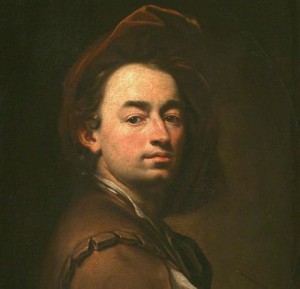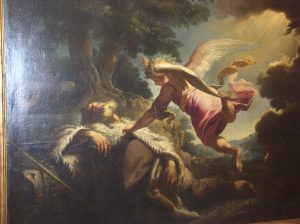Petr Brandl: A leading Baroque painter in Bohemia
By Tracy A. Burns
 A leading Baroque painter in Bohemia, Petr Jan Brandl employed strong chiaroscuro and created emotional and energetic works that are characterized by a powerful, passionate movement of colors and dramatic tension as well as a distinct tenderness. His more than 60 paintings and numerous drawings are scattered throughout Bohemia from Chyše to Hradec Králové, Prague to Litoměřice, and Kutná Hora to Kuks, among other places. Prague’s National Gallery even has an entire hall dotted with his paintings, including his famous “Simeon with the Baby Jesus.”
A leading Baroque painter in Bohemia, Petr Jan Brandl employed strong chiaroscuro and created emotional and energetic works that are characterized by a powerful, passionate movement of colors and dramatic tension as well as a distinct tenderness. His more than 60 paintings and numerous drawings are scattered throughout Bohemia from Chyše to Hradec Králové, Prague to Litoměřice, and Kutná Hora to Kuks, among other places. Prague’s National Gallery even has an entire hall dotted with his paintings, including his famous “Simeon with the Baby Jesus.”
Childhood
Born October 24, 1668, Petr Jan Brandl was the sixth child in a Czech-German family. His father, Michal Brandl, worked as a tailor and was of German ancestry. His mother, Alžběta Hrbková, was Czech from a peasant family in the south Bohemian town of Přestanice. As a child, Brandl would often gaze at the paintings in Nostic Palace of Prague’s Lesser Quarter. After dropping out of a Jesuit grammar school in the Lesser Quarter, he worked as an apprentice to court painter Kristián Schröder, who, as caretaker of the castle gallery, introduced him to Italian, Dutch, and Flemish masterpieces. Opting for a bohemian lifestyle, Brandl did not finish the apprenticeship.
Personal life and financial troubles
His personal life was fraught with problems, and he lived irresponsibly, frequenting pubs of ill repute. Sometimes Brandl called noble residences or monasteries home, but he also spent time in prison and was poverty-stricken. After abandoning his wife Helena and their three children, he refused to pay her alimony even when he was paid well for his paintings. His wife even sued him several times. Always wasting money, he seemed to be perpetually in debt. Brandl was not one to keep his promises, and sometimes it would take him years to complete a commission. For example, the prioress from the Monastery of Saint Leopold ordered a painting in 1697, giving him a generous advance, but he did not paint it until five years later. Though he had been accepted in the Old Town painters’ guild in 1694, he did not have enough money to pay the dues.
Early works
Brandl’s early work mainly consisted of altarpieces for Prague and the countryside. He modeled all his figures and groups in clay before tackling a canvas. Brandl painted an altarpiece for Prague’s Chapel at Svatá Hora near Příbram in 1697 and two more for Saint Joseph’s Church in the Lesser Quarter, for instance.
“The next Karel Škréta”
When he was 36 years old, the artistic world held high expectations of him, calling him the next Karel Škréta, a phenomenal Czech Baroque painter of the 17th century. Brandl executed an altarpiece for the Church of the Birth of the Virgin Mary in Doksany in 1703 in a stirring “Assumption of the Virgin” scene. His altarpiece of the Holy Trinity with the Virgin Mary, Saint Augustine, Saint Thomas of Villanova, and Saint Susan from 1707, commissioned for the Church of the Holy Trinity in Lnáře, was compared to “a geyser of light” by art historian Jaromír Neumann, who specialized in the Baroque period.
His mature artistic period
 Brandl’s more mature work was created during the Baroque glory years, from 1715 to 1728, at a time when sculptors František Maximilian Brokof and Matyáš Braun were dazzling artistic circles with their dramatic statuary. From 1710 to 1723, he did not produce many paintings. He devoted most of his time to his investments in a mining business based in Jílové. Instead of making a fortune, he wound up accruing more debts. Then he returned to painting full-time. From 1719 to 1723, he created seven stunning paintings for the Church of Saint Margaret at Břevnov Monastery in Prague, where his creations of Saint Vojtěch (Adalbert), Saint Benedict, and the Assassination of Saint Wenceslas continue to astound worshippers. Certainly, his “Death of Saint Benedict” ranks among his best works. In 1718, he completed an electrifying scene, “The Last Communion of the Hermit Vintíř,” for the same church. Around this time he also completed “The Death of Mary Magdalene,” now in Frankfurt, Germany, and “Joseph and his Brothers,” housed in the castle of Jindřichův Hradec.
Brandl’s more mature work was created during the Baroque glory years, from 1715 to 1728, at a time when sculptors František Maximilian Brokof and Matyáš Braun were dazzling artistic circles with their dramatic statuary. From 1710 to 1723, he did not produce many paintings. He devoted most of his time to his investments in a mining business based in Jílové. Instead of making a fortune, he wound up accruing more debts. Then he returned to painting full-time. From 1719 to 1723, he created seven stunning paintings for the Church of Saint Margaret at Břevnov Monastery in Prague, where his creations of Saint Vojtěch (Adalbert), Saint Benedict, and the Assassination of Saint Wenceslas continue to astound worshippers. Certainly, his “Death of Saint Benedict” ranks among his best works. In 1718, he completed an electrifying scene, “The Last Communion of the Hermit Vintíř,” for the same church. Around this time he also completed “The Death of Mary Magdalene,” now in Frankfurt, Germany, and “Joseph and his Brothers,” housed in the castle of Jindřichův Hradec.
Drawing inspiration from Kutná Hora
Around 1728 he moved to Sedlec near Kutná Hora and created many paintings there, such as “The Dream of Saint Luitgarde and Saint Juliana Lutisska.” The figure of Saint Luitgarde was inspired by Braun’s statue of the holy figure on Prague’s Charles Bridge. In the piece “Patrons of Bohemia with the Holy Trinity,” he painted half of his face in the center, among those of the martyrs. Visitors to the Church of the Assumption of the Virgin Mary and Saint John the Baptist at the cathedral in Sedlec, for example, can experience the passion and power of his paintings. His “Saint Vavřinec and Linhart” amazes in Saint Clement’s Church at Prague’s Klementinum, too.
Illness, debts, and death
When Brandl was 60, things took a turn for the worst. Not only did he battle illnesses, but his problems with debts also came to the fore. He was imprisoned in Hradec Králové and upon his release acquired even more debts while painting “The Assumption of the Virgin Mary” for a monastery in Kresobar, Poland. In 1733 all his paintings and clothing were confiscated, and his creditors received the money obtained from selling them. Around this time Czech literary genius Karel Čapek wrote fondly about Brandl’s picture “Saint James the Greater “in Úpice. In 1734 Brandl created, for instance, “The Holy Trinity” for the Church of Saint James in Kutná Hora and “Saint Bartholomew” for the Church of Saint Bartholomew in Kolín. The poverty-stricken painter often visited the pub At the Black Horse in Kutná Hora, where he was found dead on September 24, 1735.
An extraordinary funeral for an extraordinary man
His funeral in Kutná Hora was as dramatic as his paintings. The Cistercians from Sedlec, the Jesuits from Kutná Hora, the town council, the Mining Authority, and about 300 miners with lamps shining paid tribute to the extraordinarily talented, vagabond painter who was laid to rest in the Church of the Virgin Mary.
Brandl’s influence on Czech art
His exceptional works had a massive influence on Czech art. Brandl inspired portrait painter Jan Kupecký with his expressive self-portraits and portraits, such as that of František Antonín Špork and his “Three Women and a Hunter.” Baroque artists Jan Kryštof Liška, a specialist in altarpieces and frescoes, and Václav Vavřinec Reiner, who created frescoes, battle scenes, and portraits, learned a great deal from Brandl’s works. He also influenced Rococo painter Norbert Grund, known for his genre pictures and landscapes as well as for his representations of Biblical themes. While beating to the tune of his own drum, Brandl did not only depict scenes but dramatically told stories with each brushstroke, rendering a unique vitality that could not be surpassed.



